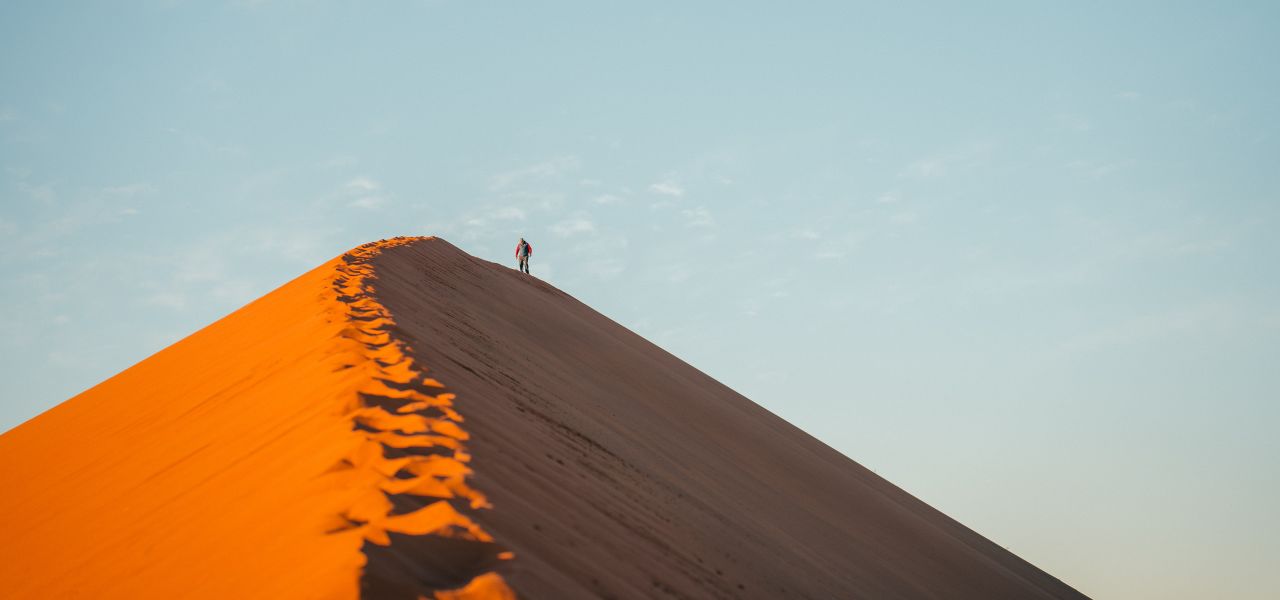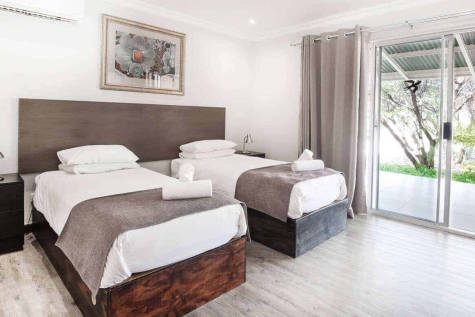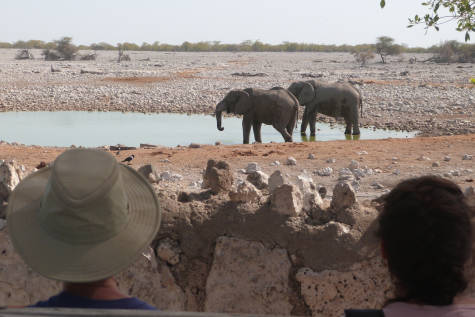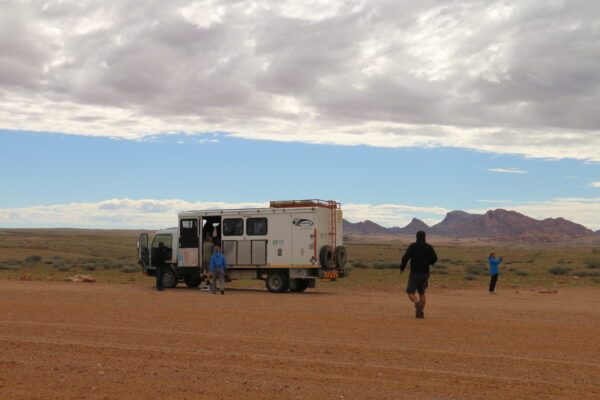Current as of: December 9, 2025 - 08:10

Discover Namibia - Lodges Trip Notes
- Ways to Travel: Guided Group
- Destination: Namibia
- Programmes: Culture
-
Activity Level:
2 out of 7 - Easy & Moderate
- 13 Days: Land Only
- Ages: 16+
- Trip Code: AZNP
- Carbon Footprint: 21kg CO2e
Trip Overview
Safari in Etosha, climb desert dunes, and track rhinos in Africa’s most underrated destination
Vast, spectacular, diverse, Namibia is the best of Africa and more. The wildlife rivals any: spend two days spotting safari animals in Etosha National Park, track rhinos, and watch water holes for any welcome visitors. You’ll also climb a desert dune, hike to the ancient White Lady rock painting, and gaze into the Milky Way at night. Better yet, you’ll be joined by one of our expert tour leaders, eager to share their Namibia.
At a Glance
- Accommodation: 12 Classic nights (lodges, chalets or hotels)
- Travel by purpose-built overland truck
- Group normally 4 to 12, plus leader. Minimum age: 16
- Itinerary also available as Discover Namibia – Camping
Highlights
- Join our much-loved tour leaders to discover the best of Namibia
- Spend two full days on safari in Etosha National Park
- Climb the highest dunes in the world in the early morning light
- Track rhinos with the help of an expert local guide
- Hike to the ancient White Lady rock painting, created by San people
- Watch over water holes and stargaze from our welcoming lodges
Is This Trip for You?
This trip has been rated Activity Level 2 (Easy & Moderate). For more information on our trip gradings, visit the Activity Level Guidelines page. If you have any queries about the difficulty of the trip, please contact us.
Most walks are of a Moderate difficulty, such as climbing Dune 45 and visiting the White Lady rock painting at Brandberg.
Travel: Transport is in a specially modified safari truck with 10 to 12 seats for group members. There is plenty of legroom and packing space plus a reference library, fridge and/or icebox. Smaller groups may be in a Toyota Hilux/Land Cruiser. By keeping the group size small, we maximise the exposure to the great African wilderness.
Road conditions: Eighty percent of Namibian roads are good gravel roads. However, road conditions are dependent on maintenance, so can be poor on occasions. This can have an impact on journey times and comfort and can be punishing on the vehicles. Drive times on this trip are moderate, and we normally arrive at our destination in the afternoon. The total distance covered is about 1,740mi (2,800km). Drive times below are approximations and do vary according to road conditions and the number of stops. We rarely exceed six hours of driving in one day.
Difficulty: There are some days where we have to get up before sunrise, but this allows us to get the most from our activities (for example, the game drives in Etosha where we are more likely to see wildlife in the early mornings before it gets too hot).
Water safety: This trip includes time by a lake, river or sea, where there may be opportunities to swim. You should always seek local advice before deciding whether to swim. Open-water or wild swim spots should be treated with extreme caution. Information on how to keep yourself safe while swimming is shown here.
Adult min age: 16
Min group size: 4
Max group size: 12
Itinerary

Land Only
- Start City: Windhoek
- End City: Windhoek
Accommodation
Guesthouses and lodges

Throughout this adventure in Namibia, we mostly stay in two- and three-star lodges and occasionally in permanent tented camps. Most properties have swimming pools, so don’t forget your swimwear.
Below are a few of the standout accommodations.
Arebbusch Lodge

Our guesthouse is only a 10-minute drive from the city centre yet is spacious with two swimming pools and one of the best pizzerias in the capital. It also has a beautiful garden enlivened with indigenous trees, which provide a habitat for a wealth of birdlife, including black-throated canaries, laughing doves and red-headed finches.
Brandberg White Lady Lodge

Our Brandberg stay is in the middle of nowhere. From the viewpoint, you will not see another property, just the ruggedly beautiful landscape of Damaraland and possibly some desert elephants in the distance. There’s a dining area, well-stocked bar, lounge, and two swimming pools.
Lodges in/near Etosha National Park

In Etosha, some departures stay within the national park itself. The lodges we use, either Okaukuejo or Namutoni, are government run and are more basic. Each has a restaurant, swimming pool and bar, but the highlights are the flood-lit waterholes where the wildlife regularly stops to drink. Other departures stay just outside the park in Etosha Safari Camp. This is a quirky property themed on a ‘shebeen’, a much-loved informal bar with local colour and bric-a-brac feel.
Worth knowing
- Wifi is available in several properties but not everywhere, notably not in Sesriem or Etosha.
- Our rooms in Etosha are the only accommodation where mosquito nets are provided, as the park is in a low-risk malaria area.
- Additional game drives may be available at the Etosha sites, which can be booked on arrival for an extra cost.
Single supplement from £ 550
Food & Drink
For meals not included, allow approximately 250-350 Namibian dollars (US$15-US$20) per person for dinner and 250 Namibian dollars (US$15) for lunch. Meals are in restaurants or at the lodges.
Meat plays a big part in Namibian cuisine. However, lodges/restaurants can cater for vegetarians if notified in advance. Please make let us know before departure if you have any dietary requests.
Transport

The vehicle normally used for this trip, including for the safaris in Etosha, is a specially modified safari truck with 10 to 12 seats. Seating is forward-facing and the windows are large and easy to open. Smaller groups may be in a Toyota Hilux/Land Cruiser. People are expected to move around to permit everyone a chance to have a window seat. There is plenty of legroom and packing space plus a reference library and icebox. Please note, it is not safe to stand when the vehicle is moving, please remain seated until the vehicle stops, even on game drives.
Weather & Seasonality
- June to August: Clear and warm during the day, but temperatures can near freezing point at night.
- September to May: Considerably warmer; October to March is the hottest, reaching the high 30Cs (around 100F). However, it is always a dry heat and the temperature drops at night. The wet season is between November and February, but this is not a bad time to go as the desert blooms after rainfall, there is plenty of birdlife to see and it never rains for very long.
Joining Instructions
Key information
Start hotel: Arebbusch Lodge, Corner of Golf & Auas Rd, Olympia, Windhoek, Namibia
Phone: +264 61 252 255
Recommended arrival time: You can arrive at any time today. There will be a welcome briefing around 6pm in the evening.
Airport: Hosea Kutako International Airport (WDH)
Getting to the start hotel
The start hotel is approximately 45 minutes’ drive from the airport. Exodus provides free arrival transfers to the start hotel from the airport for all customers.
Catching your return flight
Exodus provides free departure transfers for all customers to Hosea Kutako International Airport (WDH) from the end hotel.
Please note, unless specified otherwise, the transfers will be to the start (or pre-tour) hotel and from the end (or post-tour) hotel and will be on the date on which the tour starts/ends; transfers to other hotels in the same city and/or on different dates may attract an extra charge. Transfers should be booked with your sales representative at least two weeks before the tour starts.
Full joining instructions including local emergency numbers will be sent to you as part of our Final Joining Instructions. If you do not receive these at least a week before departure, or require them earlier please contact our office or your travel agent.
Location start: Windhoek
Location end: Windhoek
What To Take
Essential Equipment
- Torch (flashlight)
- Sun hat
- Sunscreen
- Good walking shoes
- Water bottle
- Binoculars
- Swimwear and towel
- Buff or scarf for dust
- Clothes for hot, cool and cold weather
- Recommended item: Water purification tablets
Water included
Plastic bottles are a big issue in many countries where recycling isn’t yet widely available; they often end up in landfill sites or get burned, both processes are harmful to the environment and we would like to reduce our impact here. On your trip the tap water is safe to drink throughout most of Namibia and the vehicle has a water tank. This means that safe drinking water will be available throughout and all you need to do is bring a bottle to re‐fill along the way. During the drier months, tap water may not taste as nice. If you prefer the taste of bottled water, it is possible to purchase and re-fill from 5l bottles throughout the itinerary.
If while packing you find a spare bit of space in your bag please be sure to check out our partner ‘Pack for a Purpose’ to identify items that are needed locally by schools and medical clinics. Your Tour Leader can assist with donating the items. www.packforapurpose.org/
Optional Equipment
- Temperatures in July and August can get really cold, so we strongly recommend warm clothing at these times of the year
Practical Information
Passport
Remember to check the expiration date of your passport if travelling internationally. Many countries require your passport to be valid for at least six months after the date of your scheduled return.
Visa
Namibia
Travellers from the UK, US, Canada, and some EU states need a visa to enter Namibia (see the full list here).
Visas can be obtained online (https://eservices.mhaiss.gov.na/) and you should apply for the Visa on Arrival option. Please check all visa requirements.
Please note, visa requirements often change and it is your responsibility to obtain any required visas for this trip. Therefore, we recommend that you check with the nearest embassy or consulate of your chosen destination(s), including any countries you may be transiting or transferring through.
Some local governments provide guidance on what visas their citizens need. To help, we’ve gathered a selection of useful links below.
- Australia: www.smartraveller.gov.au/destinations/africa/namibia
- Canada: www.travel.gc.ca/destinations/namibia
- United Kingdom: www.gov.uk/foreign-travel-advice/namibia/entry-requirements
- USA: www.travel.state.gov/content/travel/en/international-travel/International-Travel-Country-Information-Pages/Namibia.html
If you are transiting through South Africa and are a non-UK passport holder you may require a transit visa. Please check before travelling. Please note that if flying via South Africa you will probably have to pass immigration there.
Passports: To enter Namibia, your passport must have an ‘expiry date’ at least six months after the date you arrive. It must also have at least one blank page. If you’re travelling to South Africa, you will need an additional two blank pages.
Travelling with children: In addition to valid passports, parents travelling with children (under 18) should always carry the original or certified copy of the unabridged birth certificate (listing the child’s and both parents’ details). Adults travelling with children where they are not the biological or legal guardians of those children, should be in possession of an affidavit statement from the child’s parents giving consent for their travel. If a child is travelling with only one parent, the other parent should give consent for travel in the form of an affidavit.
Vaccinations and Health
Namibia
There are no required vaccinations. However, recommended vaccinations include hepatitis A, hepatitis B, tetanus, typhoid, cholera, rabies and tuberculosis. Malaria prophylaxis is essential, seek advice from your doctor about which malaria tablets to take. You will also need a yellow fever vaccination certificate if you’re arriving from a country with risk of yellow fever transmission or transiting for more than 12 hours through a country with risk of yellow fever transmission. Please confirm all requirements and recommendations with your doctor or travel clinic.
Local Time
Namibia's time zone: Africa/Windhoek (UTC +02:00)
Electricity
Namibia’s electricity: Plug type M (three round pins) – 230V, 50Hz

Money
Namibia's currency: Namibian dollar (NAD), though South African rand (ZAR) is widely accepted
ATM Availability
There are ATMs in the main towns and at the airport, but you should not rely on these for all your money. Credit cards are widely accepted, including at hotels, shops and restaurants.
All major denominations, including but not limited to, Pound Sterling (GBP), US dollars (USD) and Euros (EUR), are accepted at currency exchange establishments, available in all major towns and at the airport (seven days a week). If you prefer to exchange money before your arrival, it is recommended to buy South African rand.
Extra Expenses & Spending Money
Budget an average of 370 Namibian dollars (equals to US$20) a day for non-included meals and snacks.
There are several optional activities in Swakopmund, such as ocean fishing, quad‐biking and sandboarding but there’s plenty to occupy you if you don’t participate. These activities can be paid in local currency or card.
Optional excursions (prices are approximate and subject to change)
- Deadvlei transfer (if not walking to Hiddenvlei on Day 3): 220 Namibian dollars
- Quad‐biking: 890 Namibian dollars for two hours; 590 Namibian dollars for one hour
- Fat biking: 520 Namibian dollars for two hours
- Flight over Sossusvlei and Skeleton Coast: 6,500 Namibian dollars for two hours
- Ocean fishing 2,200-2,600 Namibian dollars
- Living desert tour: 900 Namibian dollars for a half day
- Swakopmund township tour: 900 Namibian dollars
- Sandboarding: Laydown for 600 Namibian dollars, stand-up for 900 Namibian dollars
- Additional Etosha safari: 750-900 Namibian dollars
- Windhoek township tour (minimum two people): 520 Namibian dollars
- Daan Viljoen Game Reserve: 150 Namibian dollars entrance fee for walking trail, plus 1300 Namibian dollars for a return transfer to the reserve
- Elephant game drive: 700 Namibian dollars
Tipping
If you feel your tour leader and support team performed well, you may want to show your appreciation of their services. The sum you choose to give is entirely personal, but as a guide we suggest the equivalent of around US$5 per person per day. For other staff, such as porters and guides on optional activities, we recommend you budget for a further US$5-US$8 per day.
In most restaurants and bars, tipping 10% is common and may be added to your bill. This tip is voluntary and can be declined if service was unsatisfactory.
Sustainability and Impact
As a certified B Corp, we’re on a mission to improve our social and environmental impact across all our adventures.
We do this through our innovative Thriving Nature, Thriving People plan.
This ‘nature positive’ approach is designed to help nature and communities thrive in harmony through practical solutions, such as reducing carbon and waste on our trips, supporting conservation projects through the Exodus Adventure Travels Foundation, and rewilding 100 square metres for every Exodus traveller.
You’ll also find Thriving Nature, Thriving People moments across our trips. These experiences are often a highlight of your adventure, while also benefiting the natural world or local communities.
On this trip, we:
- Spot cheetahs in the Namib Carnivore Conservation Centre, a research and educational project that works to return rescued animals to the wild
- Track wild rhinos on foot with an expert guide who teaches you about the vital rhino conservation efforts and anti-poaching initiatives
- Can join an optional township tour in Windhoek for an educational insight into the daily lives of the residents
Important Information
Optional activities and excursions
If you would like to join an optional activity or excursion outside those listed in the itinerary, your leader may be able to assist with selecting a provider. However, Exodus has not assessed the safety standards of activities or excursions that are not listed in the Trip Notes. All optional activities or excursions are undertaken at your own risk.
Important Information
Your Safe Participation
When booking this trip, you should be confident in your ability to participate in all activities described in these Trip Notes. If you have any doubt about your suitability, please call us and ask to speak to one of the experts on this itinerary.
Although our leaders are well trained to deal with different capabilities, if they have any concerns about someone’s ability to safely take part in an activity, or their impact on other people’s enjoyment, we authorise them to take necessary action which, in some circumstances, may involve asking someone to miss that activity.
By booking this trip you agree to our Booking Conditions which clearly state that our leaders have the authority to do this. In these rare instances we will ensure anyone sitting out is safely provided for and offered alternative options where possible. Refunds will not be provided for activities missed and customers may be liable for additional costs incurred.
Seatbelts
All vehicles used by us should be equipped with working seatbelts, except where approved by us based on the vehicle type or journey. Wherever seatbelts are available, we require our customers to use them for their own safety, even where it may not be a legal requirement.
Travel Safety
For additional information please have a look at the travel safety advice page on our website.
How to Book
Speak to our friendly team of experts to plan your adventure:
- Check availability: our website shows real-time availability or contact our team by phone, email or live chat.
- Hold a space: You can provisionally hold a space to give you time to finalise your travel plans.
- Confirm your booking: Payment of a deposit will complete your booking and secure your place on the trip.
After booking
You will receive a confirmation document and invoice, which includes extra information and guidance about your travel arrangements. Our dedicated Customer Operations team will help you with any pre-travel questions or arrangements and can easily add extensions or extra accommodation to your booking. Final Joining Instructions will usually be sent out two to three weeks prior to departure.
Adding transfers to your booking
If you have arranged your own flights and would like to add transfers to your booking, please provide your arrival and departure details to our Customer Operations team around four to six weeks before departure.
- Where free transfers are included, they are available for any flight but can only be added to your booking once we have received your flight schedule.
- Where group arrival and departure transfers are available, these operate at fixed times. You will need to arrive in time to meet the scheduled transfer. If the timings don’t align with your travel plans, our team can arrange private transfers once they receive your flight schedule.
Trip Note validity
Trip notes may be updated after booking; if any updates significantly impact the inclusions or itinerary you will be advised in writing. A link to the most up-to-date Trip Notes will be sent out with your Final Joining Instructions before departure.
The information in these Trip Notes is given in good faith. All holidays can be subject to unexpected changes, and occasionally it may not be possible to follow the itinerary as planned. In these circumstances we will make the best-possible alternative arrangements that maintain the integrity of the original itinerary.

